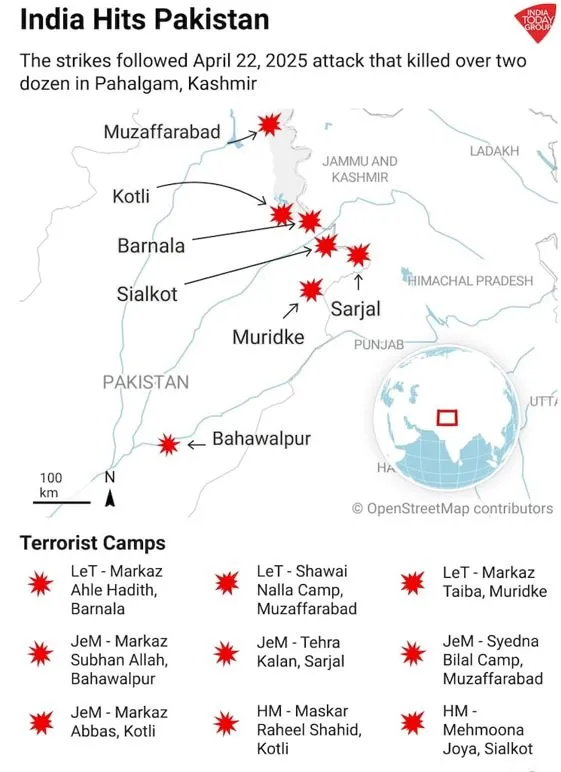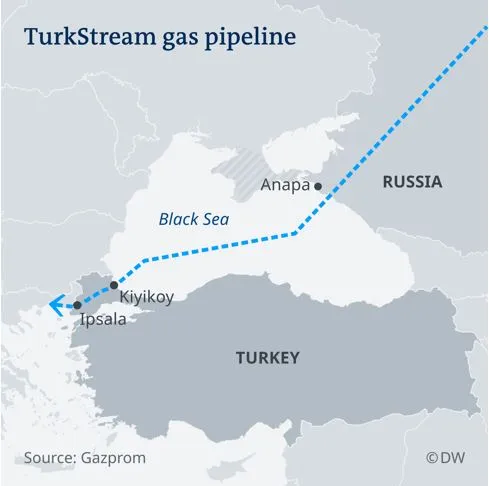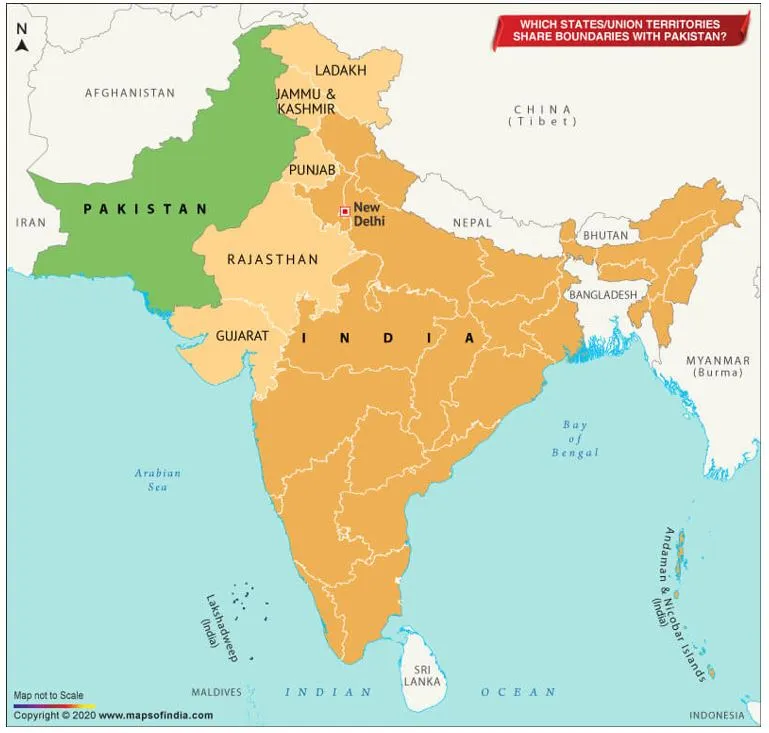

8th May 2025 (11 Topics)
Mains Issues
Context
What is Operation Sindoor?
- Operation Sindoor is a meticulously planned military offensive targeting terrorist infrastructure in Pakistan and Pakistan-occupied Kashmir (POK). It wasn't just a big strike against terror infrastructure.
- It was the biggest anti-terror operation inside Pakistan, and the biggest military strike since the 1971 War.
- The immediate reason cited for the operation was to “deliver justice” to the victims of the Pahalgam terror attack, which killed multiple security personnel.
- However, India framed Operation Sindoor not as a one-off reaction but as a response to decades of Pakistan-sponsored terrorism, dating back to the 2001 Indian Parliament attack.
- India shifted the causal chain from the Pahalgam attack to a long-term pattern of cross-border terrorism, signaling that no major act of terror will be seen in isolation.
- Terrorist groups like Jaish-e-Mohammed and Lashkar-e-Taiba — both UN-designated entities — were highlighted as persistent actors behind these attacks.
- India described Operation Sindoor as:
- “Focused”
- “Measured”
- “Non-escalatory”
- This signals to:
- Pakistan: Future escalation could involve conventional military targets.
- International Community: India is acting against terrorism, not provoking war.

Doctrine of Sub-Conventional Targeting
- India maintained its doctrine of limited strikes — targeting terror infrastructure, not the Pakistan military.
- Similar to the 2016 surgical strikes and the 2019 Balakot airstrikes, Operation Sindoor:
- Avoided escalation into full-scale war.
- Sent a signal that terrorism will be met with proportional and precise force.
- Escalation Control in Practice The Ministry of Defence stated:
“No Pakistani military facilities have been targeted.” - This indicates an effort to retain strategic restraint while demonstrating operational resolve.
Sites Chosen by India (Terror Hotspots)
The operation targeted nine terror camps located in Pakistan-occupied Kashmir (PoK) and mainland Pakistan.
|
Site |
Strategic Importance |
|
Muridke, Punjab
|
LeT’s Markaz Taiba camp — alleged training centre for perpetrators of 2008 Mumbai attacks, including Ajmal Kasab. |
|
Bahawalpur, Punjab |
JeM’s Markaz Subhanallah headquarters — described as a hub for recruitment, training, and indoctrination. |
|
Muzaffarabad, PoK |
LeT’s Sawai Nala camp and JeM’s Syedna Bilal camp — training and staging areas for attacks, including April 22 Pahalgam killings. |
|
Kotli, PoK |
LeT’s Gulpur camp, Abbas camp, and HuM’s Mehmoona Joya facility — training grounds for up to 15 militants at a time. |
|
Bhimber, PoK |
Barnala camp — training in weapons, IEDs, and jungle survival. |
|
Sialkot, Punjab |
Sarjal camp — training ground for individuals involved in the killing of four police officers in March in Kashmir. |

Precision Weapons Likely Used in the Operation
India has not officially disclosed the exact weapons used in Operation Sindoor. However, based on known Indian capabilities and official hints at "niche-technology weapons," the following advanced systems are most likely involved:
|
HAMMER (Highly Agile and Manoeuvrable Munition Extended Range) |
Strategic Relevance: Ideal for surgical strikes with minimal collateral damage, particularly in terrorist hideouts close to civilian areas. |
|
SCALP (Storm Shadow) |
Strategic Relevance: Used for deep strikes, including targets well inside Pakistan beyond the LoC and IB. |
|
METEOR Missile |
Strategic Relevance: Though not a strike weapon, Meteor ensures air superiority, enabling IAF aircraft to operate deep in hostile airspace during operations like Sindoor. |
|
BRAHMOS Supersonic Cruise Missile |
Strategic Relevance: With rapid strike ability and precision, BrahMos is crucial for targeting hardened terror infrastructure with minimal warning time. |
|
LOITERING MUNITIONS (Suicide Drones) |
Strategic Relevance: Vital for real-time intelligence and precision elimination of moving or high-value terrorist targets. |
- Operation Ablaze (1965): Pre-emptive mobilisation by the Indian Army in April 1965 after the Rann of Kutch clashes; demonstrated India's readiness before the August war.
- Operation Riddle (1965): India’s military response to Pakistan’s infiltrations (Ops Gibraltar and Grand Slam) in J&K; led to full-scale war and ended with the Tashkent Agreement.
- Operation Cactus Lily (1971): Major Indian offensive in East Pakistan; involved Meghna River crossing, aiding rapid advance to Dhaka and aiding Bangladesh’s liberation.
- Operation Trident (1971): Indian Navy’s successful missile strike on Karachi harbour on Dec 4; caused major damage to Pakistan’s navy and fuel reserves.
- Operation Python (1971): Follow-up naval strike on Karachi post-Trident; further damaged Pakistan’s naval assets and disrupted logistics.
- Operation Meghdoot (1984): India’s pre-emptive occupation of Siachen Glacier; secured key passes like Bilafond La and Sia La to deny Pakistan control.
- Operation Vijay (1999): Military operation during the Kargil War to evict Pakistani intruders from Indian territory along the LoC; restored status quo.
- Operation Safed Sagar (1999): IAF’s air campaign during Kargil conflict; targeted enemy positions at high altitude to assist ground operations.
- 2016 Surgical Strikes: Cross-LoC strike by Indian Special Forces targeting terror launch pads in PoK post-Uri attack; marked shift in India’s response doctrine.
- Operation Bandar (2019): IAF air strike on JeM camp in Balakot post-Pulwama attack; first cross-LoC air raid since 1971, led to India-Pak aerial face-off.
- Operation Sindoor (2025): Precision air strikes by India on 21 terror camps across PoK and Pakistan in retaliation for the Pahalgam attack; showcased tech-driven retaliation.
PYQQ. Operations undertaken by the Army towards upliftment of the local population in remote areas to include addressing of their basic needs is called: (2024)
Solution: (c) |


Mains Issues
Context
The war in Ukraine has created a major energy crisis in Europe. Since Russia’s invasion in 2022, the European Union (EU) has been trying to reduce its reliance on Russian gas and energy. The EU’s new plan aims to phase out Russian gas completely by 2027, but some EU countries are still buying more Russian energy. The TurkStream pipeline is a key factor in this, as it continues to bring Russian gas into Europe.
EU’s Plan to Stop Buying Russian Gas by 2027
- In response to Russia’s invasion of Ukraine, the European Commission set a goal for the EU to stop importing Russian gas by 2027. This plan asks countries to create their own strategies to reduce gas imports from Russia.
- Although Russian pipeline gas imports have fallen significantly (from over 155 billion cubic meters (Bcm) in 2021 to under 40 Bcm in 2024), Russian LNG (liquefied natural gas) exports to Europe have increased.
- Countries like France, Belgium, Spain, and the Netherlands now buy more LNG directly from Russia.
- S. LNG as an Alternative: The EU is also looking for alternatives to Russian gas. U.S. LNG exports to Europe are expected to increase by 15% in 2025, which could help replace some of the Russian gas.
- However, U.S. LNG is more expensive than Russian gas, and the U.S. requires long-term contracts, which may not align with the EU’s goals to reduce emissions and stay flexible.
- Opposition from Some European Countries
- Hungary and Slovakia are two countries in Central and Eastern Europe that have opposed the EU's plan to phase out Russian gas. These countries argue that it would lead to higher energy prices and hurt their economies.
- Although Russian gas is cheaper, most of the price benefits go to Gazprom, Russia’s state-owned energy company, rather than to European consumers.
What does this mean for the future?
The EU’s efforts to stop using Russian gas face many challenges:
- TurkStream Pipeline: This pipeline remains a key source of Russian gas into Europe. If the EU wants to cut off all Russian energy, it will need to address this pipeline.
- Alternatives: The EU is turning to U.S. LNG as an alternative, but it comes at a higher cost and long-term contracts.
- Energy Security: The EU must find ways to secure enough energy from different suppliers without becoming overly dependent on one source.
About TurkStream Pipeline
 |


Mains Issues
Context
India and the United Kingdom finally signed a Free Trade Agreement (FTA), after nearly three years of negotiations. The deal comes at a time when global trade faces uncertainty due to rising tariffs, particularly those initiated by the US. It marks a major post-Brexit milestone for the UK and is expected to boost bilateral trade significantly.
Key Takeaways from India–UK FTA
- Trade Expansion Potential: The agreement is projected to enhance bilateral trade by approximately British Pounds 25.5 billion annually by 2040. In 2024, total trade stood at British Pounds 42.6 billion, indicating a substantial opportunity for growth.
- Tariff Rationalisation
- Spirits and alcoholic beverages: Tariffs on whisky and gin are to be gradually reduced from 150% to 40% over a decade—offering relief to the UK's Scotch whisky industry and Indian consumers alike.
- Automotive sector: Tariffs exceeding 100% on select UK vehicles will be lowered to 10% under a quota-based mechanism.
- Other goods: Concessions have been extended to items such as medical devices, aerospace components, cosmetics, chocolates, biscuits, lamb, and salmon, many of which are core to UK’s export basket.
- Movement of Professionals: India sought liberalisation in professional mobility, especially for its IT and healthcare workforce. The final arrangement is modest, allowing for approximately 100 additional annual visas, indicating limited progress in this domain due to the UK's political sensitivities around immigration.
- Regulatory Challenges Addressed: Negotiations also confronted and eventually navigated contentious issues such as the UK's proposed carbon border tax on high-emission imports (notably metals), which could have disadvantaged Indian exporters. The two sides arrived at a mutually acceptable understanding.
Significance for India
- Strategic Market Diversification: The agreement enables India to further its quest for alternative trade partners and reduce strategic vulnerability, especially in light of geopolitical frictions and China-centric supply chain risks.
- Support for Domestic Manufacturing: By easing access to the UK market for Indian goods, the FTA is expected to create a more favourable environment for initiatives such as ‘Make in India’, particularly in textiles, pharmaceuticals, engineering goods, and agri-products.
- Post-Brexit Opportunity Realisation: For India, this FTA serves as an opportunity to gain more predictable access to the UK market, especially as London seeks to deepen economic linkages beyond the European Union.
- Muted Gains in Services: According to the Global Trade Research Initiative (GTRI), the deal may not substantially transform India's export landscape, since many Indian products already enter the UK with low or zero tariffs. Gains in the services sector, which remains a core Indian interest, appear rather limited.
What is a Free Trade Agreement (FTA)?
|
PYQQ. Consider the following countries: (2018)
Which of the above are among the ‘free-trade partners’ of ASEAN?
Solution: (c) |


Mains Issues
Context
For decades, Pakistan has been a focal point in discussions about terrorism, primarily because of the close connections between its security forces, particularly the Inter-Services Intelligence (ISI), and various militant groups. These groups have become key tools in Pakistan's foreign policy, particularly in its approach toward India, Afghanistan, and the broader region.
Roots of the Terror Infrastructure: The Soviet-Afghan War
- The origins of Pakistan's militant networks trace back to the Soviet-Afghan War (1979–1989).
- During this period, Pakistan used jihadist groups as a counterforce against the Soviet invasion of Afghanistan.
- The ISI played a central role in recruiting and training fighters, many of whom became part of a larger, more complex web of terror organizations.
- Initially, these groups were focused on fighting against the Soviet forces, but after the war ended, they evolved to pursue Pakistan’s broader strategic objectives, especially targeting India and influencing Afghanistan.
- Key Terror Groups with Links to Pakistan
- Lashkar-e-Taiba (LeT): Founded in the early 1990s, LeT has been one of Pakistan's most prominent proxy organizations. Its primary objective is to carry out attacks against India, particularly focusing on Kashmir.
- Training and Operations: LeT operates training camps not just in Pakistan, but also in Pakistan-occupied Kashmir (PoK). Their infamous attacks, such as the 2008 Mumbai attacks, have left a lasting mark. LeT has also been implicated in various other incidents, such as the 2006 Mumbai train bombings and attacks on Indian military establishments.
- Jaish-e-Mohammed (JeM): Founded in 2000 by Masood Azhar, JeM has been responsible for numerous high-profile attacks against India, including the 2001 Indian Parliament attack and the 2019 Pulwama suicide bombing.
- Unlike LeT, JeM specializes in suicide bombings, particularly using fidayeen (suicide) attacks.
- Support Structures and State Links: Pakistan's terror infrastructure isn’t just about these two groups. Several smaller but significant outfits also play a role in its broader strategy. For example:
- Lashkar-e-Taiba (LeT): Founded in the early 1990s, LeT has been one of Pakistan's most prominent proxy organizations. Its primary objective is to carry out attacks against India, particularly focusing on Kashmir.
- The Haqqani Network, which operates primarily in Afghanistan, serves as both an ISI proxy and a facilitator for anti-India operations. Even though it operates in Afghanistan, it has longstanding ties with Pakistan's military establishment.
- ISIS-Khorasan (ISIS-K), an offshoot of the Tehrik-i-Taliban Pakistan (TTP), operates in Afghanistan and Pakistan's tribal areas. While ideologically opposed to Pakistan, there are indications that some elements within the Pakistani security establishment tacitly allow their operations, particularly in areas of mutual interest.
Financing and Radicalization
A key aspect of Pakistan's terror network is its financing and radicalization mechanisms.
- Charitable Fronts: Many terror groups rely on religious charities as a primary source of funds. These groups are often registered as humanitarian organizations but funnel money into militant activities.
- State Sponsorship: Despite officially claiming to be part of the global "War on Terror" post-9/11, Pakistan’s security apparatus continues to support certain terror groups, often in the form of direct funding. Estimates suggest that Pakistan allocates between $100-125 million annually to these groups.
- Money Laundering and Smuggling: Networks like hawala (illegal money transfer systems) and narcotics trafficking play an important role in funding terrorist activities. The Afghanistan-Pakistan-India corridor is a major route for the drug trade, generating substantial revenue for these organizations.
- Radicalization Infrastructure: Madrassas (religious schools) are a central feature of Pakistan's radicalization process. There are over 30,000 madrassas in Pakistan, with around 10-15% directly linked to extremist organizations.
- Pakistan’s continued support for terrorism poses significant challenges to regional stability, particularly in South Asia.
- India remains the primary target of these terror organizations, suffering both direct attacks (like the Mumbai attacks and Pulwama bombing) and indirect effects (such as the long-term instability in Kashmir).
- The international community has long recognized the need to address Pakistan’s role in sustaining these terror networks.
- Pakistan’s repeated appearance on the Financial Action Task Force’s (FATF) grey list highlights the systemic failure to curb terror financing. The FATF has demanded that Pakistan take concrete actions to dismantle these networks, yet little progress has been made.


Prelims Articles
Context
The Chenab River almost ran dry in Jammu & Kashmir’s Akhnoor sector near the Line of Control (LoC), after the sluice gates of two major dams — Salal and Baglihar — were closed for desiltation. The river’s level returned to normal a day later when the water release was resumed. This event came shortly after India put the Indus Waters Treaty (IWT) of 1960 in abeyance.
Understanding the Chenab River
- The Chenab River originates in Himachal Pradesh (Bara Lacha Pass in the Lahul-Spiti part of the Zaskar Range) and flows through Jammu & Kashmir before entering Pakistan.
- Through the plains of Punjab (Pakistan), it joins the Satluj after receiving the waters of Jhelum and Ravi rivers, before ultimately flowing into the Indus River.
- It is one of the three “Western Rivers” under the Indus Waters Treaty (IWT) — the others being the Indus and the Jhelum.
- As per the IWT, Pakistan has control over the waters of these three rivers, but India is allowed limited use for:
- Domestic and non-consumptive purposes
- Limited agriculture (as per specific cusec limits)
- Run-of-the-river hydroelectric projects (no large-scale storage or diversion)
India’s Dams on the Chenab (Technical Highlights)
|
Project |
Type |
Height |
Capacity |
Operator |
|
Salal Dam |
Concrete gravity dam |
81.38 m |
690 MW |
NHPC |
|
Baglihar Dam |
Concrete-face rockfill dam |
143 m |
450 MW (Stage-I) |
J&K Power Development Corp. |
- Both are run-of-the-river dams — allowed under IWT with strict technical guidelines to prevent large-scale diversion or storage.
- These dams are vital for J&K’s energy security and part of a broader strategy to tap hydroelectric potential in the region.
Indus Waters Treaty (IWT)
|


Prelims Articles
Context
Pakistan resorted to heavy shelling in the border districts in Jammu and Kashmir along the Line of Control and the International Border hours after India launched 'Operation Sindoor' in retaliation to the Pahalgam carnage, in which terrorists gunned down 26 civilians. The shelling and firing led to the injury and death of civilians.
India-Pakistan Border:
- The India-Pakistan border, also called the International Border (IB), extends from Jammu and Kashmir in the north to the Zero Point between Gujarat in India and Sindh province in Pakistan.
- Spanning a total length of 3,323 km, this frontier is one of the most sensitive and heavily guarded borders in the world.
- Visibility from Space: Due to the installation of approximately 150,000 floodlights on 50,000 poles, this border is visible from space at night, symbolising the scale of India's security measures.
- Indian States and Union Territories Sharing Border with Pakistan (Total: 3,323 km)
- Jammu and Kashmir: 1,222 km
- Rajasthan: 1,170 km
- Gujarat: 506 km
- Punjab: 425 km
- The Border Security Force (BSF) is India's border protecting organisation on its border with Pakistan and Bangladesh. It is one of the five Central Armed Police Forces of India, and was raised in the awaken of the 1965 War on 1 December 1965.



Prelims Articles
Context
The U.S. is pursuing a significant minerals deal in Africa's Great Lakes region, particularly focusing on the Democratic Republic of Congo (DRC). This initiative is a response to the M23 rebel group seizing control of key mining areas, threatening vital mineral resources.
Minerals Present in Africa
- Africa is rich in essential minerals, many of which are critical for global industries like electronics, renewable energy, and defense. The key minerals include:
- Tin, Tungsten, and Tantalum (3T minerals): These are important for electronics manufacturing, used in smartphones, laptops, and other technology.
- Cobalt: Crucial for electric vehicle (EV) batteries and renewable energy technologies.
- Gold: Widely mined across the continent, used for various industrial and financial purposes.
- Copper: A key metal for electrical wiring, used in renewable energy infrastructure.
- Diamonds: Important for both industrial applications and luxury goods.
Key Locations
- Democratic Republic of Congo (DRC): Particularly in the Kivu provinces (North and South Kivu), the DRC is rich in tin, tungsten, coltan, and cobalt. The southern Katanga region is especially known for cobalt and copper.
- South Africa: Known for its platinum group metals (PGMs), gold, and diamonds.
- Zimbabwe: Rich in platinum, gold, and diamonds.
- Namibia: Significant sources of copper, zinc, and uranium.
- Ghana: One of the largest gold producers in Africa.
- Mozambique: Known for tantalum and coal.
These regions are central to the global minerals trade and face ongoing challenges related to conflict, illegal mining, and geopolitical competition.


Prelims Articles
Context
India has climbed four places to rank 130th out of 193 countries in the United Nations Human Development Index (HDI) 2023, as per the report titled “A Matter of Choice: People and Possibilities in the Age of Artificial Intelligence” released by the United Nations Development Programme (UNDP). The improvement reflects India’s gains in health, education, and income, but also highlights persistent inequality and gender gaps.
Key Findings of the 2023 HDI Report
- India’s Performance:
- HDI Score: Improved from 644 (2022) to 0.685 (2023) — still within the Medium Human Development category.
- Life Expectancy: Rose to 72 years (from 67.7 in 2022).
- Expected Years of Schooling: Increased to 13 years.
- Average Years of Schooling: Rose to 9 years.
- GNI per capita (PPP 2021): Increased from USD 6,951 to USD 9,047.
- Inequality-Adjusted HDI (IHDI) drops to 0.475, reflecting a 30.66% loss due to disparities in health, education, and income.
- Gender Inequality and Development:
- Gender Development Index (GDI): 0.874 (women: 0.631; men: 0.722).
- Gender Inequality Index (GII): India ranks 102nd, score 403; gaps persist in political participation, workforce presence, and reproductive health.
- Comparative Regional Position:
- India shares HDI rank with Bangladesh (130th) but lags in life expectancy.
- Pakistan ranks 168th (score: 0.544), Nepal 145th, and Sri Lanka leads regionally at 89th.
- Among BRICS: India lags behind China (75th), Brazil (89th), Russia (59th), and South Africa (110th).
- Global Trends: HDI progress globally has slowed, with widening gaps between high and low HDI countries since 2020. The report warns of potential long-term setbacks to 2030 SDG targets if the trend persists.
- AI and Human Development:
- The report highlights the dual role of Artificial Intelligence — as a driver of productivity and risk of inequality.
- India reports the highest global prevalence of self-reported AI skills and plans a national AI computing infrastructure.
- AI is already being applied in agriculture, insurance, and subsidy distribution in India.
About the Human Development Index (HDI)
|


Editorials
Context
India conducted precision military strikes at nine locations in Pakistan and Pakistan-occupied-Kashmir, targeting major terrorist infrastructure including the Jaish-e-Mohammed headquarters in Bahawalpur and Lashkar-e-Taiba base in Muridke. The operation, named Operation Sindoor, was in response to the April 22 Pahalgam terror attack that killed 26 civilians.
Shift in India’s Counter-Terror Strategy
- Measured Military Response: The strikes were described as “measured, non-escalatory, proportionate, and responsible”, indicating a calibrated approach to cross-border counter-terrorism.
- Targeted Infrastructure Destruction: High-value terrorist camps in Bahawalpur and Muridke — symbolic and operational centres of JeM and LeT — were targeted, going beyond border-proximate zones.
- Strategic Signalling: This overt use of military power serves as a deterrent message that India will no longer limit its response to covert or diplomatic means post-terror attacks.
Diplomatic and Domestic Dimensions
- International Outreach: India has briefed major powers including the US, UK, and Russia, highlighting its commitment to responsible conduct by avoiding civilian or economic targets.
- Internal Political Unity: All political parties have expressed support for the operation, strengthening internal political consensus on India’s national security approach.
- Communal Harmony Focus: The government emphasized that the attackers sought to disturb Kashmir’s normalcy and provoke communal tensions, urging restraint from internal destabilizing elements.
Pakistan’s Strategic Behaviour and India's Preparedness
- Pakistan’s State-Sponsored Terrorism: Despite global scrutiny, Pakistan continues to use terrorism as a strategic tool under nuclear deterrence cover, and houses terror groups on its soil.
- Long-Term Challenges: Destroying camps may have immediate impact, but Pakistan’s radicalization pipeline and institutional support for terror pose enduring threats.
- Need for Vigilance and Preparedness: India must remain alert for potential retaliation and escalate diplomatic and military responses as required, while concluding investigations like the Pahalgam attack effectively.
Practice Question
Q. Discuss the evolving contours of India’s counter-terrorism doctrine in light of recent cross-border precision strikes. How does this reflect a shift from strategic restraint to strategic deterrence? Evaluate the diplomatic, military, and internal security dimensions.


Editorials
Context
Recent developments — Pakistan Army Chief Gen. Asim Munir's speech reasserting the Two-Nation Theory, and Bangladesh's demand for apology and reparations for the 1971 war atrocities — have reopened South Asia's unresolved historical and ideological questions, exposing Pakistan's continued reliance on religious nationalism, historical denialism, and internal repression.
Reassertion of Ideology by Pakistan
- Ideological Reaffirmation by Military: Pakistan’s Army Chief General Asim Munir, in April 2025, invoked the Two-Nation Theory, claiming Muslims and Hindus are “fundamentally different” in religion, tradition, culture, and ambition, thereby reinforcing religious essentialism as the basis of national identity.
- Use of Nationalism as Political Distraction: The speech reflects an attempt to distract from Pakistan’s internal crises — including political instability, economic fragility, and insurgency — by reviving outdated ideological tropes rooted in Jinnah’s vision of separation.
- Textbook Nationalism and Institutional Myth-Making: The Two-Nation Theory continues to be institutionally propagated through school curricula and public discourse, entrenching a narrow and divisive sense of national identity, despite its historical contradictions post-1971.
Bangladesh’s Counter-Narrative and Demands
- Demand for Historical Accountability: In April 2025, during Foreign Secretary-level talks, Bangladesh formally demanded a long-pending apology for Pakistan Army’s atrocities during the 1971 Liberation War and sought over USD 4 billion in reparations for its share of undivided Pakistan’s assets.
- Contradiction Between Diplomacy and Memory: Despite signs of diplomatic normalisation with Pakistan, 1971 remains a core issue in Bangladesh’s national consciousness, creating a paradox between strategic engagement and collective trauma.
- Moral Assertion over Strategic Realism: Bangladesh’s demand is rooted in ethical recognition of state-sponsored brutality, not strategic hostility — signifying a principled stance for historical justice, rather than a purely transactional foreign policy.
Implications of Ideological Rigidity for Pakistan
- Failure to Learn from East Pakistan: The continued denial of ethnic-linguistic grievances, seen earlier in East Pakistan and now in Balochistan, shows Pakistan’s repetition of authoritarian patterns, ignoring lessons from its own disintegration in 1971.
- Externalisation of National Identity: Pakistan’s identity remains reactive and India-centric, defined by contrast rather than internal coherence, thus limiting national integration and foreign policy maturity.
- Obsolete Ideology Amid Contemporary Challenges: The persistent invocation of the Two-Nation Theory does not address modern threats like terrorism, separatism, and regional isolation; instead, it entrenches militarised nationalism devoid of democratic introspection.
Practice Question
Q. “The revival of the Two-Nation Theory in Pakistan's political discourse underscores its inability to reconcile with its historical failures and regional responsibilities.” Critically examine in the context of Pakistan-Bangladesh relations and South Asian regional stability.

Editorials
Context
India has improved its position in the 2025 Human Development Report (HDR) titled "A Matter of Choice: People and Possibilities in the Age of AI", moving from rank 133 in 2022 to 130 in 2023, with an increased HDI value of 0.685, despite global developmental slowdown and widening inequality.
Progress in Human Development Indicators
- Rise in HDI Value: India’s HDI increased from 676 (2022) to 0.685 (2023), showing strong recovery post-pandemic in health, education, and income dimensions.
- Improvement in Life and Learning: Life expectancy rose to 72 years, the highest since 1990, and expected years of schooling grew from 2 years (1990) to 13 years (2023).
- Income Growth: Gross National Income (GNI) per capita rose significantly from USD 2,167.22 in 1990 to USD 9,046.76 in 2023, reflecting economic upliftment.
Policy Initiatives and Social Impact
- Role of Welfare Programmes: Initiatives like MGNREGA, RTE Act, and NRHM have been instrumental in advancing human development outcomes.
- Poverty Reduction: Between 2015-16 and 2019-21, 5 crore Indians exited multidimensional poverty, a major contributor to India’s HDI progress.
- Gender and Income Inequality Warning: Despite overall improvements, HDI loss due to inequality stands at 30.7%, one of the highest in Asia, driven by income and gender disparities.
Gender Disparities and the Role of AI
- Female Labour Participation: Although it rose to 7% in 2023-24, sustainable employment requires stronger support systems and inclusive policies.
- Political Underrepresentation: Lack of implementation of 1/3rd reservation for women in legislatures remains a bottleneck for gender parity.
- AI and Development: India retains 20% of global AI researchers (up from nearly 0% in 2019), and must use AI to boost services in education, health, and governance—while ensuring equitable access and regulatory safeguards.
Practice Question
Q. Despite improvements in Human Development Index ranking, India continues to suffer significant losses due to inequality. Critically evaluate the role of public policy in addressing these disparities, and assess how emerging technologies like AI can be integrated into human development without deepening existing gaps.



